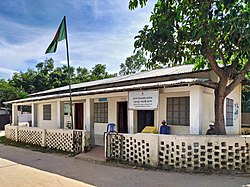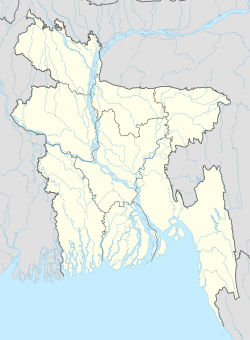Nayapara refugee camp
নয়াপাড়া শরণার্থী শিবির | |
|---|---|
 Office of the Camp-in-Charge in Nayapara | |
| Coordinates: 20°57′22″N 92°15′05″E / 20.955979°N 92.251312°E | |
| Country | |
| Division | Chittagong |
| District | Cox's Bazar |
| Upazila | Teknaf |
| Population (2024)[1] | |
• Total | 24,760 |
The Nayapara refugee camp (Bengali: নয়াপাড়া শরণার্থী শিবির) is a refugee camp in Teknaf Upazila, Cox's Bazar District, Chittagong Division, Bangladesh. It is inhabited almost exclusively by Rohingya people who have fled from religious persecution in neighbouring Myanmar. It is one of two government-run refugee camps in Cox's Bazar District, the other being the larger Kutupalong refugee camp.
Background
[edit]The Rohingya people, a predominantly Muslim ethnic minority in Myanmar, have historically been persecuted in the Buddhist-majority country.[2] Militant attacks by Rohingya rebels in 2016 prompted a violent crackdown on Rohingyas by the Myanmar military, the Tatmadaw. Consequently, hundreds of thousands of Rohingyas fled across the border to Cox's Bazar District, Bangladesh, settling mainly in two government-run refugee camps, Nayapara and Kutupalong, which have since become one of the densest places in the world.[3][4]
Demographics
[edit]The Nayapara and Kutupalong refugee camps had a combined population of around 30,000 refugees in July 2017, almost all of whom were Rohingyas.[5] The United Nations High Commissioner for Refugees (UNHCR) estimated that the combined population of the two refugee camps had increased to over 77,000 by September 2017.[6] On 14 January 2018, the estimated population of Nayapara refugee camp was 23,065.[7] The UNHCR recorded a population of 24,760 in the Nayapara refugee camp on 31 July 2024.[1]
2021 fire
[edit]On 14 January 2021, a fire in the camp destroyed around 550 shelters, 150 shops, and a community center, resulting in the loss of homes and belongings of 3,500 Rohingya refugees.[8] The UN World Food Programme, Inter Sector Coordination Group, and Bangladesh Red Crescent were among the organizations offering assistance to victims.[9]
References
[edit]- ^ a b "Rohingya Refugee Response – Bangladesh: Mapping of Refugee Population as of 31 July 2024". United Nations High Commissioner for Refugees. Retrieved 19 June 2025.
- ^ "The young and the hopeless in Bangladesh's camps". United Nations High Commissioner for Refugees. Retrieved 2 September 2017.
- ^ "Rohingya Refugee Crisis Explained". www.unrefugees.org. United Nations High Commissioner for Refugees. Retrieved 19 June 2025.
- ^ "Stories from the Rohingya Camps in Bangladesh". 5 September 2016. Retrieved 14 July 2017.
- ^ "Two camps of thought on helping Rohingya in Bangladesh". United Nations High Commissioner for Refugees. Retrieved 14 July 2017.
- ^ Judah, Jacob (15 September 2017). "Rohingya influx strains camp resources in Bangladesh". United Nations High Commissioner for Refugees. Retrieved 4 October 2017.
- ^ "How Aung San Suu Kyi sees the Rohingya crisis". BBC News. 25 January 2018. Retrieved 10 October 2022.
- ^ McPherson, Poppy Elena; Paul, Ruma (14 January 2021). Cameron-Moore, Simon (ed.). "Fire destroys homes of thousands in Rohingya refugee camps". Reuters.
- ^ "UN steps up support for thousands left homeless after fire at Rohingya refugee camp". UN News. United Nations. 15 January 2021. Retrieved 10 October 2022.
